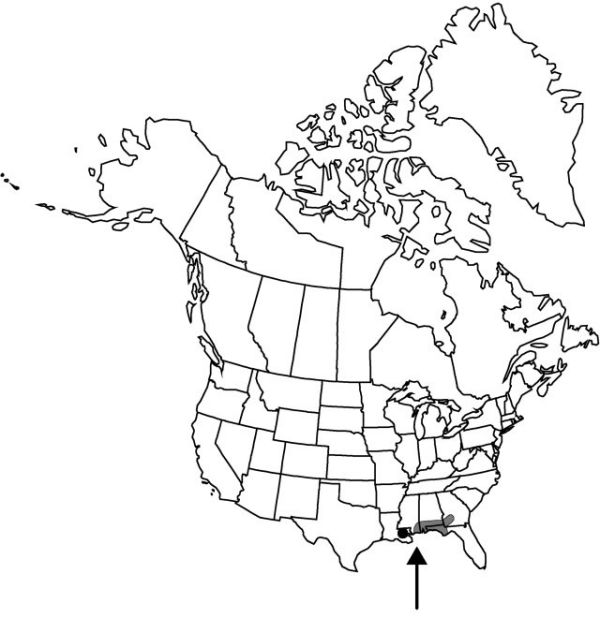Hymenocallis choctawensis
Pl. Life 18: 70. 1962.
Bulb rhizomatous, ovoid to subglobose, 3–6 × 1.5–5 cm; basal plate 1.5–5 cm; neck 2–8 cm; tunic grayish brown. Leaves deciduous, 5–9, arching upward to suberect, 3.5–7.5(–8.5) dm × 2.5–6 cm, coriaceous; blade shiny green, oblanceolate, channeled proximally, distinctly wider beyond middle before tapering gradually towards base, not glaucous, apex acute. Scape 3.5–6.2 dm, 2-edged, glaucous; scape bracts 2–3, enclosing buds, 3–4(–6) × 1.5–2 cm; subtending floral bracts 2.8–3.7 cm × 10–15 mm. Flowers 2–8(–12), opening sequentially, highly fragrant; perianth tube green, 6–11 cm; tepals slightly ascending to spreading, white, tinged green on keel and at base, 8–12 cm × 5–9 mm; corona white with small, yellowish green eye, funnelform, gradually spreading, shortly tubulose proximally, 2.5–4(–4.6) × 4–5.5 cm, margins between free portions of filaments irregularly 2- or 3-dentate, projections ranging from slight to prominent; free portions of filaments inserted on flat sinal base, suberect, white, 2.5–4 cm; anthers 1.5–2.5 cm, pollen golden; ovary ovoid, 1–1.5 cm × 5–10 mm, ovules 1–3 per locule; style green in distal 1/2, fading into white proximally, 13–19 cm. Capsules broadly conic to subglobose, 3–4 × 3 cm. Seeds obovoid to elongate, 2–3(–4) × 1.4–2.3 cm. 2n = 44.
Phenology: Flowering spring–early summer.
Habitat: Swamp and floodplain forests, stream and river banks
Elevation: 0 m
Distribution

Ala., Fla., Ga., La., Miss.
Discussion
Hymenocallis choctawensis is not well known (G. L. Smith et al. 1991). It is most abundant along the stream banks and swamp forests of the central and western Florida panhandle. It has great horticultural potential due to its large, oblanceolate, shiny green leaves and showy inflorescences that may have up to but rarely more than eight flowers. The long, spreading tepals and the funnelform staminal corona that gradually spreads in time are especially distinctive (G. L. Smith and N. C. Coile 1999; G. L. Smith and M. A. Garland 1996).
Most herbarium specimens of Hymenocallis choctawensis encountered in this study have been misidentified as either H. caroliniana or H. occidentalis. It is readily distinguished from H. occidentalis on herbarium sheets by its rhizomatous bulb and triangular bracts that are not long-tapering.
Selected References
None.